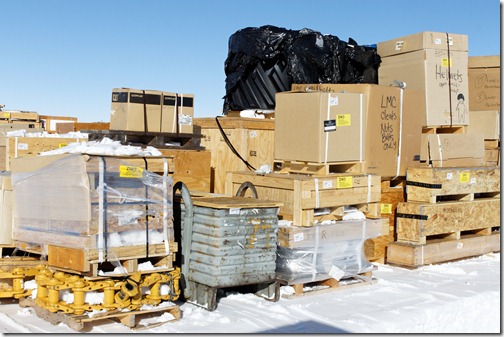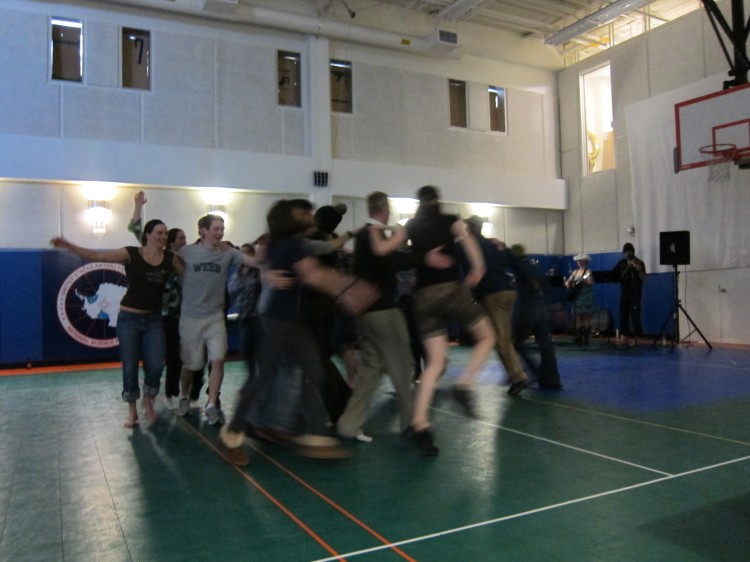A few days ago I did a live chat with two classes of 3rd graders in St. Paul who are learning about Antarctica. To prep for the Q&A, their teacher Mitchell told me, they played with mint-breath cold winds, made eyewear to ward 24 hour daylight rays, played sightless/wordless blizzard rescue, and made models of the Gamburtsev Mountains which they later covered with handmade snowflakes. They had some really good questions! Check ’em out!
Shekina asks How was your breakfast?
me: Hi Shekina! I haven’t had breakfast today, but I normally have fresh eggs when they are available–they have to be flown in from New Zealand, a country near Australia. I think that makes them taste special.
Griffin: Have you ever fell through the ice?
me: I did fall through the ice once–I was shoveling near the small aircraft landing pad last year and I fell into a 12 foot hole. Luckily there is no water here at South Pole, so I landed on top of a buried building, not in the ocean.
Charlie: Have you ever gotten lost?
me: No, we stay pretty close to the station most of the time. I got a little lost the first time I tried to find my bedroom, but not scary lost.
Imani: What is your favorite thing to do there?
me: I like to play games, dance, make art and exercise on my days off–we have one day off a week, Sundays, and we have to spend it wisely. My favorite thing would be hard to choose!
Mandeq: Do you ever see animals at Pole?
me: Not normally, since we are 800 miles away from the coast and there is no food or water for animals here. When the over ice traverse came in (like a tractor road trip that brings us fuel) a BIRD came with them! It was so crazy to see a living animal here–they announced it over the intercom so everyone could look.
Gunnar: How cold is it there now?
me: Right now it is -23 F with a windchill of -47 F.
It will get down to -100 in the middle of winter (june)
Tyler and Qiana: Have you ever ridden/touched a polar bear?
me: I wish! That would be so cool. We don’t have polar bears in Antarctica, though, they live in the northern hemisphere.
Addie: have you ever gotten stuck in the snow?
me: Not STUCK stuck, but sometimes it can be really hard to walk in deep drifting off station–you would lose your boots if they weren’t tied on!
Melissa: Do you stay warm in your cold gear?
me: Yes, they give us plenty of warm clothing–jackets, snowpants, boots, long underwear, fleece pants, mittens, neck gaiters. Sometimes I get cold when I work outside for a long time, but not too cold normally.
Austin: Ever seen an iceberg?
me: I have seen sea ice from the plane into McMurdo station (on the coast) but I don’t think I’ve seen an iceberg.
Amir: What is the hardest thing to do there, in your opinion?
me: Good question.. I think the hardest thing we do (in terms of work) might be the jobs of the people who defuel the airplanes–they work outside all day every day, and the planes are really loud, they have to carry heavy fuel hoses around, and they smell like stinky fuel.
Anna: Whats the highest temperature since you’ve been there?
me: Actually, we hit a record this year–it got to TEN degrees above zero. It felt so warm!
Sasha: Is it ever warm in your room?
me: It depends on the room. This year my room is so warm I can’t even wear socks to bed. Last year, in another room, I had snow on my bed sometimes, because it would blow in through the cracks!!!!
Georgia : Is the Jamesway comfortable?
me: It can be. I like my room a lot this year. It can get a little stinky though, because we are only allowed to shower twice a week to save water, and lots of people don’t have doors, only curtains.
Mitchell: from the class – what are you doing today?
Mrs. Voglegesangs 3rd grade class says “Thank you”!!!!
switching to other class
me: Well, today I am going to unpack a bunch of frozen food that we have stored outside (everywhere is like a big freezer) and we are going to prepare food for the winter.
Thank you all!! Nice to meet you!
Mitchell: How do you prepare food for the winter if it’s already frozen?
me: Well, we are stocking it so they can access it. It stays outside in the summer, and we need to move it with tracked loaders because the containers are thousands of pounds each– we unpack it and keep it in inside frozen storage because the tractors freeze in the winter and we can’t use them.
Mitchell: back in the other class, Hello!
me: hello from south pole station!
Cedes: How cold has it been lately?
me: It’s been around -25 F the past few days, and the windchill is going down again, getting to about -50
Adam Me.: Seen any polar bears?
me: Unfortunately, no! Polar bears live in the Northern Hemisphere, they don’t come all the way down here. Maybe I’ll see one someday if I ever go to the north pole.
Emily: How long have you been at the South Pole?
me: I have spent eight months here total–four months last year, and almost four months this year–since October!
Eddie: What do you like about the South Pole?
me: I like a lot of things, but mostly I like the people who I work with, getting to be outside,and getting to see the sun 24 hours a day.
Josh Wo.: What jobs do you do there?
me: My job last year was shoveling–lots of shoveling!!–and cleaning up/removing dirty ice in the vehicle maintenance facility. This year I work with inventory–counting things, lots of them stored outside, and putting them away (I get to use forklifts and tracked loaders)
Kenisha: Do you like sleeping in the tents (Jamesways)?
me: Some times I like it a lot, other times it’s no fun to go outside in the sunlight and cold to brush my teeth before bed–it wakes you up!
Quiante: What types of animals live there?
me: None, actually! We live 800 miles away from the coast and Antarctica is technically a desert, so there is no food or water for animals. We have to melt ice for people to drink, and all our food comes on airplanes.
Charlotte: What is your favorite activity for fun?
me: I like dancing–we dance every weekend here!
Josh Wa.: When did you first go to Pole?
me: My first time was October of 2010. But the first person to ever get here was 100 years ago, a Norwegian named Roald Amundsen.
Celia: If you could, would you live there year round?
me: I want to spend a full year here sometime, and to see the winter and the 6 month night. I think it would be really cool. You can only be here for a year at a time though.
Charlie: Have you slept in a sleeping trench and have they ever caved in? (happy camper pictures)
me: I haven’t slept in a trench myself, but my friends have! No one has had theirs cave in, at least not this year.
Chloe: How many people live there?
me: In the summer (now) there are about 250 people–scientists and the people they need to support them, like me. In the winter, there are about 45 people.
Ella: Is it comfortable to wear all your snow gear?
me: It’s pretty bulky–it can be hard to get in and out of vehicles, go up stairs or work (like shoveling!) Lots of us bring our own jackets since they are more comfortable.
Connor: How long did it take to get there?
me: A few days– from Minneapolis we fly to New Zealand–about 20 hours of flights. From NZ to McMurdo is 5 hours, then to South Pole is 3 hours’ flight.
Sandy: What’s the biggest hill you’ve slid down?
me: Ob Hill in McMurdo is really tall, like a mini mountain! I climbed up that and slid down on my bottom. It was fun, and fast!
Grace K.: Is the bed you sleep on soft or hard?
me: Pretty soft, but sort of old. Like summer camp.
Tess: Do you get scared during the blizzards?
me: It can be sort of unnerving to not be able to see the station, but I have a radio on me so if I was ever lost I could call for help.
Kara: Is it hard to be out in the cold that long?
me: Yes, very. Working outside is a very challenging part of my job.
Alaysia: How do you break the ice?
me: Well, to get ships to McMurdo for food, they have a special ocean vessel called an icebreaker. For things on station, we use shovels and icepicks and other tools.
Zoe: Can you go skating there?
me: The ice we live on is like packed snow, so not really unfortunately.
Will: What kinds of food do you eat?
me: We eat normal food, like from a cafeteria–sometimes we get fresh vegetables, which is really exciting and we have a small greenhouse to grow our own veggies. But we have things like hamburgers and soup and cereal, or more exciting things sometimes, like Thai food.
Mitchell: Kiell, thank you for responding to our questions and spending time with us!
~
What about you? Do you have any questions for me?

















